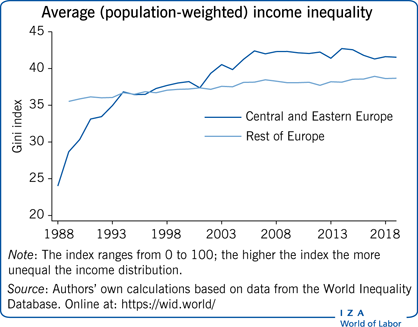Elevator pitch
High levels of economic inequality may lead to lower economic growth and can have negative social and political impacts. Recent empirical research shows that income and wealth inequalities in Eastern Europe since the fall of socialism increased significantly more than previously suggested. Currently, the average Gini index (a common measure) of inequality in Eastern Europe is about 3 percentage points higher than in the rest of Europe. This rise in inequality was initially driven by privatization, liberalization, and deregulation reforms, and, more recently, has been amplified by technological change and globalization coupled with relatively ungenerous income and wealth redistribution policies.

Key findings
Pros
Income inequality grew radically in Eastern Europe during the transition to market economies.
The rise in inequality is significantly higher when fiscal data with better coverage of top incomes are used to measure inequality.
Major determinants of increased income inequality include market reforms, the rise of private capital, and relatively low levels of income redistribution.
Wealth inequality in some Eastern European countries is among the highest in Europe.
Cons
Income and wealth distribution data for Eastern Europe are imperfect and inequality estimates are very uncertain.
Household survey data suggest that income inequality in Eastern Europe is generally close to the EU average level.
Wealth inequality increased in all ex-communist countries, but on average it is lower than in other European countries.
Income redistribution in Eastern Europe seems to be slowly converging to Western European levels.